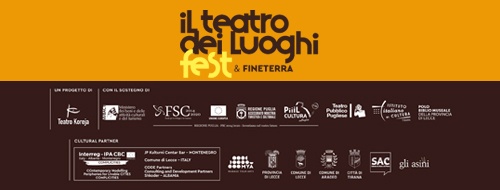|
We live in strange times dominated by a sence of widespread disorientation where places are designed and defined by walls, borders, and boundaries. There is one ‘sense' that manages to escape and resist this simplistic vision based on a fear of encountering others and of sharing. Physical places are the ones most suitable for making the best of our times, they are privileged observation points and hubs for the safeguarding of interpersonal and human relations and contexts, and they even offer us, at times, the opportunity to ponder the tightly interwoven quality of the stories that inhabit them, thereby allowing us to tear down, or pass through, the physicality of walls, allowing for the borders which criss cross them to become more maleable and open. Identity, relations, belonging, inclusion, migration, and limits are some of the factors that leave room for a decline to take place as far as the meaning of certain places goes.
Art is one of the languages that bonds the most to a particular place and attempts to set in motion a truly generative process of interpretation.
Art of the Places is not an exhibition in and unto itself, nor a pre-determined art itinerary to follow, Art of the Places offers itself as a experience in enjoyment of which its reverberating effects ripple outwards and are felt by the inhabitants and within the territory in which they live every day, producing a healthy short circuit somewhere between isolation and openess. The works of Mauro and Giuri and the workshop activity of Bianco-Valente represent signs of good-neighborliness and of closeness, and they encapsulate the essence of living; the act of experiencing life in a specific space, place, or territory, even if for just a short period of time. l'arte dei luoghi Art of the Places is counting on a type of art that will be able to play a role in stimulating wide-ranging reflection on the world and on our elusive condition as contemporary beings. The project aims at supporting the art of younger artists present within the territory and to initiate processes of actie citizenship through experimental training practices with internationally renowned artists working in the field of relational art.
MARCO PETRONI is a design theorist and critic. He has collaborated with La Repubblica Bari newspaper and directed the magazines Design Plaza and Casamiadecor, has handled the Sud column on Abitare.it, and was a copy editor at FlashArt. He currently collaborates with the online edition of Domus. He is Senior Curator at the Plart Foundation Museum Research Centre in Naples. He develops innovative curatorial projects and events related to the themes of project culture with a transdisciplinary approach, such as Botanica by Studio Formafantasma, Naturally Combined by Mischer'Traxler, and The future of Plastic by Officina Corpuscoli, among others. He has published several essays including "Mondi Possibili", notes on the theory of design (Edizioni Temporale), and Going real, the value of the project in the era of postcapitalism (Planar Books). He has lectured at NABA Art and Design Academy in Milan, at the Design Academy Eindhoven, and at the London Design Museum. He currently teaches History of Design at the Fine Arts Academy of Naples and Digital and New Media for Fashion at the Polytechnic University of Milan.
BIANCO-VALENTE (Giovanna Bianco and Pino Valente) began their artistic project in 1994 investigating body-mind duality from a scientific and philosophical point of view. These studies were followed by an evolution in design that aims to make interpersonal connections visible. Examples include installations that have involved various historic buildings, followed by many other works focused on the relationship between people, and events and places. They have exhibited in Italy and abroad for important museums and public spaces, among which MAXXI, Rome; MACBA, Barcelona; Madre Museum, Naples; Factory 798, Beijing; Palazzo Strozzi, Florence; The Milan Triennale Design Museum; Reina Sofia Museum, Madrid; and has carried out site specific projects also in Lebanon, Morocco, New York, Rio de Janeiro, and Stockholm.
STEFANO GIURI Stefano Giuri lives and works in Florence, where he graduated from the Academy of Fine Arts. In his work, he analyzes the connections and relationships that exist between the concepts of public and private space, hovering somewhere between collective and individual memory, in order to face current social problems related to the places he works in. He understands the idea that in every single memory there are signals, traces, and schemes present which are tied to eras and historical, cultural contexts. In his artistic practices, he focuses his interst on areas such as performance and sculpture.
GABRIELE MAURO Gabriele Mauro, was born in Aradeo in 1991. He lives and works in Florence. The research he develops revolves around the concept of art and of clichés found in society of which he carries out a simple and ruthless analysis. The social fabric of a city leads him to reflect on the role that artists have and on the meaning of contemporary art, so as to look for new communication mechanisms. Among some of the main themes of his artistic production: a reflection on current modes of how we receive information; on art as a construction of forms and as a conversation on the value of authenticity, and on the concept of image as a series of temporal relationships. And lastly, imagination as an escape route but also as a place to return to, and on the intrinsic expressive power that images have in society, so as to keep an objective outlook on themes such as visual sensitivity and critical awareness.
|
